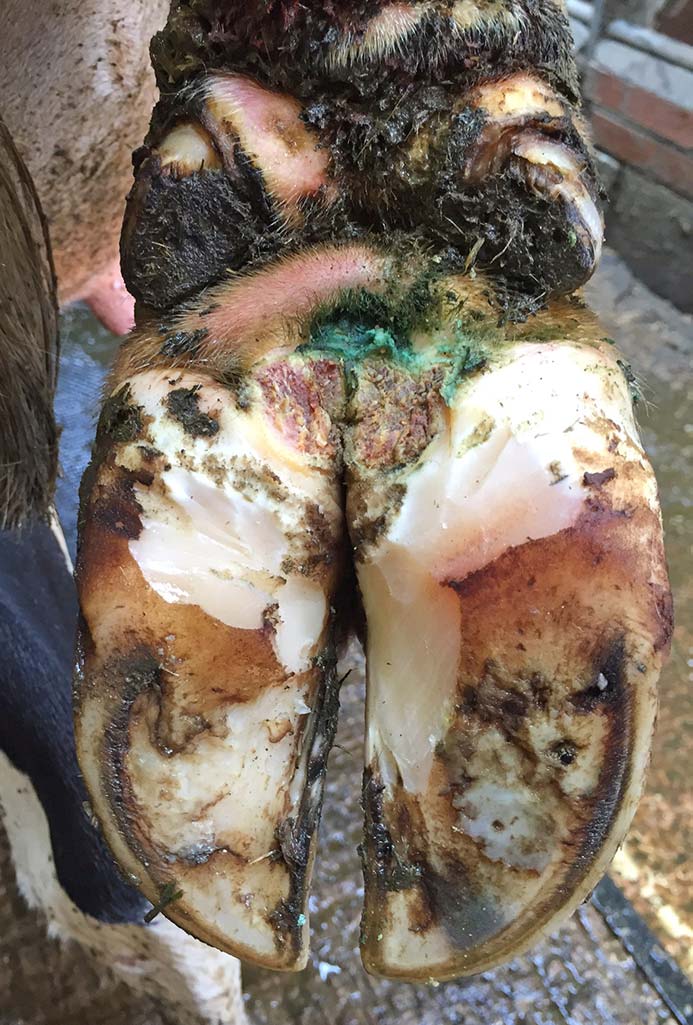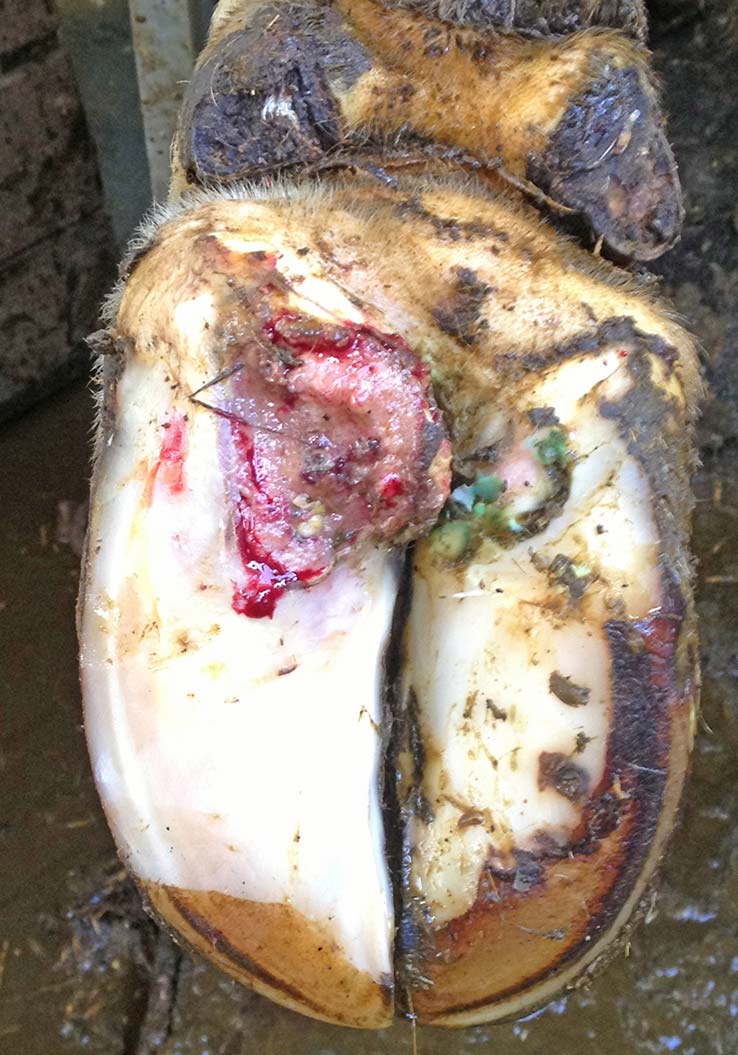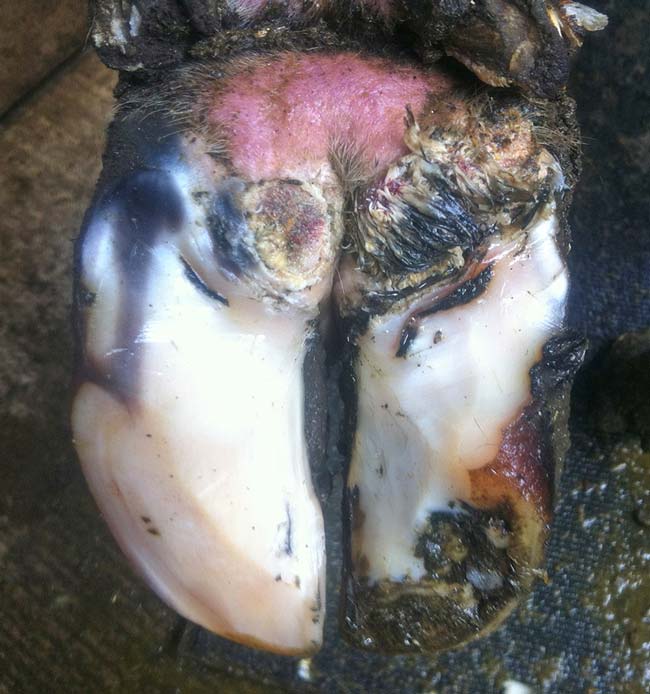14 Nov 2016
Digital dermatitis – a dominating lame condition of bovine hooves
John Dawson looks at this worldwide foot problem in dairy cattle, how the bacteria infects animals on farm, treatment of the individual and herd, and prevention.

Trimming workshops aid proper corrective trimming and treatment.

Digital dermatitis (DD) is a highly contagious, erosive infection and the main infectious condition affecting the health of our national herd’s feet.
It was first reported in Italy in 1974 and took 14 years before it was first reported in Britain. Since 2009, it has been reported to be present in the majority of UK herds and is now a worldwide problem seen in all countries with dairy cattle (Carter, 2016).

This ubiquitous lameness problem has increased in the face of intensive agricultural practices, which have been blamed for its spread. However, intensive agricultural practices do not automatically result in a DD problem. Many herds that vigilantly adhere to control regimes either manage to have very low levels of DD or avoid infection altogether. It is not so prevalent in less intensive herds and low in pastoral settings, such as New Zealand and Chile.
Clinical findings
DD usually affects the skin on the bulbs of the heel, but it can also be found between the digits or on all of the area above the coronary band. When left untreated, it can invade the corium and interfere with horn formation – causing separation of the sole and wall. It affects the sensitive dermal layers and, therefore, is an extremely painful condition often causing severe lameness and a characteristic odour.
DD is much more prevalent if there is contact with slurry, poor hygiene and wet conditions. National Animal Disease Information Service data shows a higher instance of DD during September to November – corresponding to housing in.
Financial implications
Significant cost implications are associated with DD in a herd as the disease lowers milk production, can affect fertility and has treatment and labour costs. Estimates of its cost range from £50 to £100 per case.
Heifers are susceptible to DD and can lose 335kg of milk in their first lactation. Also, if they contract the disease as a heifer, they are more likely to get it again later in life – sometimes repeatedly. Outbreaks can be explosive in a naïve herd.
Infectious agent
The infectious agent consistently identified in both bovine and ovine DD is the spirochaete genera Treponema, which is a mobile bacteria. At least three species of treponemes are known to cause DD.
The bacteria are thought to penetrate the skin through the weakest points, such as hair follicles and sebaceous glands, which is how deeper structures get infected.
The bacteria has also been found in the gut and transmission is thought to pass from the gastrointestinal tract to the foot, as well as from foot to foot.
Treponemes can survive for up to two days in slurry, but a major route of transmission is still thought to be cow-to-cow via direct contact.
The DD treponemes have a spiral cell shape – the most common shape for the Treponema. One of the most conspicuous treponemes identified is the species Treponema pallidum – the cause of syphilis – which has a flat and wavy cell structure.
Treponemes are very difficult to grow in the laboratory, but the three species most commonly isolated are T denticola, T pedis and T phagedenis.
Identifying the particular strain of Treponema causing a case of bovine DD is important because it helps analyse pathogenic mechanisms, helps monitor the disease, can be used to test possible treatments, identifies routes of transmission and could be used in the potential development of a vaccine. The same bacterial strains can be shared between different host species, such as cattle and sheep, suggesting actual transmission occurs between these different animals.
A very similar infectious condition – contagious ovine DD, first seen in flocks in the UK in 1997 – is now an emerging disease within UK flocks. It is a serious lameness problem within the flock with lesions becoming more severe than bovine DD, believed to be caused by the same Treponema.
Increased risk and intensity of infection occurs when:
- sheep and cows are on the same farm
- animals are brought in
- animals are kept housed
- animals are kept in a slurry or wet environment
- animals have been exposed to DD as heifers
Individual treatment

Treating the individual infected animal remains the most effective method of cure. The area around a lesion must be trimmed to expose the whole infected area and debrided for best results. This requires the hoof to be lifted and individual topical treatment applied. Only one antibiotic preparation is licensed for topical use – oxytetracycline. All others are off licence and should not be used. Other non-antibiotic treatment agents are
also effective.
Most cases require only one application by this method to clear the lesion. However, severe lesions may require repeated treatments, which should be done at intervals of two days. Application of a light bandage after this treatment can aid the contact time of the active agent to allow deeper penetration and a more effective cure. However, treating individually is often not an option due to time constraints and the number of animals affected within the group.
Importance of trimming
Picking up each foot allows assessment of the hoof conformation and trimming to rebalance the foot and remove excess horn where needed. Horn removal and remodelling the claw reduces infection levels and helps penetration of applied products to effect a cure.
Treatment products
A plethora of topical treatment products are available, including oxytetracycline sprays and many pastes, with active ingredients being either copper, zinc, iodine or peracetic acid. Although copper sulphate has proved to be an effective treatment, a report (Shearer et al, 2015) highlighted it caused delayed healing and pain after application. Therefore iodine products have been developed and are being used as they are not as painful after application and are more environmentally acceptable.
Whole herd treatment
Whole herd treatment with foot baths is the most widely used treatment method, although it has variable efficacy. The outcome of this treatment depends on:
- the active ingredient used
- its concentration
- how it is applied to the foot
- how often it is applied
- environmental cleanliness of the walking area after treatment
Many products are commercially available that essentially act by disinfecting the hoof. When foot baths are used, the hoof needs to be as clean as possible to allow maximum penetration. It needs to be submersed in the foot bath at least 3cm to 4cm above the coronary band and kept clean for a reasonable amount of contact time.
An effective foot bathing protocol needs to be specific to the farm, taking into account its own microclimate, economics and farm layout as no “one size fits all” regime exists. After implementing a farm-specific foot bathing regime, compliance and mobility scoring should be recorded. Ideally, weekly mobility scoring should be carried out to monitor the effectiveness of the protocol introduced and modifications can then be made if no progress is seen.
Preventing the infection entering a non-infected herd, or returning to one where it has been eradicated, is a question of biosecurity and measures to prevent infection levels.
Strategies to reduce the risk of DD in a herd include:
- keep a closed herd
- don’t keep sheep with cattle
- adopt high standards of cattle husbandry (see further on)
- adopt a foot bathing regime that is easily administered, maintained and monitored
- biosecurity – disinfect all materials on and off the farm and in contact with the animal
- a regular foot trimming regime to ensure excellent conformation, hoof shape and hoof quality

Cattle husbandry strategies to reduce DD include:
- well-ventilated housing with natural sunlight
- well-maintained concrete with plentiful non-slip walking areas
- adequate areas for easy stress-free movement of cattle
- adequate standing area with minimal contamination
- adequate water points and feeding areas to reduce contamination around them
- excellent slurry clearing methods (bacteria can live up to two days in slurry)
Once measures have been implemented and are effective, they have to be strictly employed to prevent recurrence.
Summary
DD has a marked effect on the welfare and economical performance of a herd. Its control is often overshadowed by the volume of the daily work routine. However, it can be effectively controlled within a well-managed environment contributing greatly to the economical viability of the herd.
Latest news





